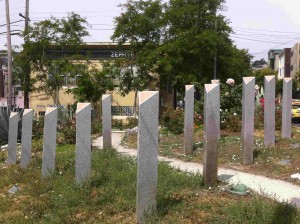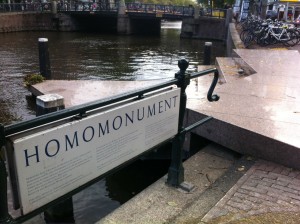International approaches to LGBTQ public history
17 February 2015 – Claire Hayward
2014 saw huge steps forward in representations of LGBTQ (Lesbian, Gay, Bisexual, Transgender, Queer, and Questioning) lives in public history on both sides of the Atlantic. Projects have been launched in both the United States and the United Kingdom that aim to reveal national histories of LGBTQ lives, highlighting the ways that international conversations about approaches to public history are developing and impacting positively on the practice of public history.

Monumento en memoria de los gais, lesbianas y personas transexuales represaliadas, Barcelona, ES. Inscription reads: “In memory of the gays, lesbians and transsexual persons who have suffered repression throughout history, Barcelona 2011.” Photo credit: Claire Hayward
In May 2014, the US National Park Service (NPS) announced it would be launching an LGBTQ Heritage Initiative. The aim of this unprecedented project is to reveal the untold LGBTQ histories of landmarks and historic sites across the US, and the results of the project so far can be seen in this Google Map of Places with LGBTQ Heritage. At the roundtable to launch the event, the academics and public historians involved pointed out that this project was so important because LGBTQ history is America’s history. The roundtable discussants stated that the contributions of LGBTQ people to society have been ignored for too long, and their experiences must be placed in a wider discourse to ensure that their history is no longer marginalised. As such, while the results of this initiative are yet to be seen, its significance to LGBTQ history, as well public history in general, is already clear.
Also in the US in 2014, the National Museum of American History (NMAH) held a donation day for LGBTQ-related objects. While Andrea Witcomb has argued that American public history prioritises the “giving of voice” through specialist identity-based museums, the donation day at the NMAH marks a different approach. Comparing the US and Australian approaches to public history, Witcomb highlighted that in the US there is a range of specialist identity museums, while the approach in Australia is instead to embed identity narratives within their national histories. For example, there are museums for African-American history, disability history, women’s history, Jewish history, American-Indian history, Italian-American history, Latino history, Pacific Asian history, and LGBT history in the US.
The approach in the UK matches Australia’s: there are two Jewish museums and two Romany history museums in the UK, but that is the extent of our ‘specialist’ identity museums. Instead, there is a greater focus on integrating LGBTQ histories into our museums in permanent displays, particularly in social history museums, such as the inclusion of the gay rights movement in ‘World City: 1950s-Today’ at the Museum of London. The development of LGBT History Month in the UK (February) since 2004 has resulted in an increased focus on temporary exhibitions to celebrate this month in public history institutions, with for example, the National Trust hosting its first LGBT History Month exhibition in February 2014 at Sutton House. However, this often means that LGBTQ histories are represented only once a year rather than fully integrated into collections and displays, particularly in smaller museums that do not have the same resources as the Museum of London.
A significant problem with the UK approach is that there is no collective understanding or guide to the best ways to represent LGBTQ histories in the UK, unlike in Australia, where Museums Australia published the Gay and Lesbian Policy Guidelines in 1999. A set of such guidelines would greatly benefit museums and ensure that all museums have a basic understanding of why and how to collect and embed LGBTQ histories. Our UK Museums Association has done great work in highlighting the social justice role of museums, with for example Museums Change Lives, but a practical guideline to representing LGBTQ and indeed other marginalised histories would have a significant impact on representation outside of LGBTQ History Month.
As in the US, however, the UK approach is developing and beginning to move away from the embedding and History Month approach. English Heritage has very recently followed suit to the US and the NPS with the announcement of an LGBT History Project. Similar to the NPS Heritage Initiative, the project will aim to reveal and document untold LGBTQ histories in the UK historic environment. As well as recording LGBTQ historic sites and buildings, this project highlights that LGBTQ heritage is part of English heritage and will in turn hopefully influence other public history institutions to recognise and represent LGBTQ histories as part of wider narratives.
Also in this past year, international conversations about LGBTQ public history were fostered at the Un-Straight Museum conference. The keynote papers, which you can watch online here, highlighted case studies from the UK, US, Sweden, and Germany. The conference was named after the Unstraight Museum, a Swedish-based online museum that collects virtual donations to document ‘unstraight’ lives, in turn transcending international boundaries in terms of the objects collected and the location of virtual visitors.
Memorials and their use of the Pink Triangle have also transcended these international boundaries during the last three decades. In Amsterdam, Sydney, Barcelona, San Francisco, and Uruguay, among others, the Pink Triangle is used as a symbol of collective remembrance to LGBTQ people in the design of memorials, despite many of these locations having no direct link to the Holocaust. The internationally recognised Pink Triangle not only memorialises those LGBTQ people who were persecuted during the Holocaust but recognises continued prejudice and symbolises a promise to prevent the persecution of LGBTQ people today.
2014 and the development of projects and approaches have shown what an exciting time it is for both LGBTQ and public history. The projects and collections announced this year also highlight the growing development of international public history, making it clear that international communities are taking and building on ideas from each other. These developments, and discussions to come in the US, UK, Australia, and indeed further internationally outside of English-speaking and Western countries, will further bring to light the benefits of different approaches. An international approach that takes on board a whole range of methods and ideas can only serve for a more representative, and thus better, public history.
~ Claire Hayward is a PhD candidate at Kingston University, London, UK, working on the ways that public history represents the histories of same-sex love.





